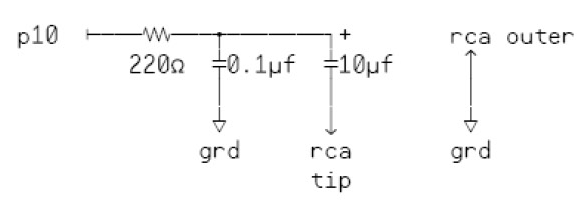Connecting an AMP to a Propeller
I'm connecting a simple audio amp to my Propeller Proto board, this is a little different than a stamp, so I wanted to clarify a few things and not add more components than i need to.
here is the post about the amp
http://forums.parallax.com/showthread.php?p=688548
I looked at the Propeller cook book and it shows a simple circuit for connecting a RCA jack to the propeller for sound output. the circuit consists of a 22Ohm resistor a 0.1uF and 10uf cap. if I'm going straight into an amp do I need the caps? I'm guessing the resistor is there to limit current and the caps are for when the bass kicks it doesn't brown out.
if the circuit was designed to connect to and stereo (amp) I'd bet I Would need them with my amp.
Some insight would be helpful!
▔▔▔▔▔▔▔▔▔▔▔▔▔▔▔▔▔▔▔▔▔▔▔▔
A complex design is the sign of an inferior designer. - Jamie Hyneman, Myth Buster
here is the post about the amp
http://forums.parallax.com/showthread.php?p=688548
I looked at the Propeller cook book and it shows a simple circuit for connecting a RCA jack to the propeller for sound output. the circuit consists of a 22Ohm resistor a 0.1uF and 10uf cap. if I'm going straight into an amp do I need the caps? I'm guessing the resistor is there to limit current and the caps are for when the bass kicks it doesn't brown out.
if the circuit was designed to connect to and stereo (amp) I'd bet I Would need them with my amp.
Some insight would be helpful!
▔▔▔▔▔▔▔▔▔▔▔▔▔▔▔▔▔▔▔▔▔▔▔▔
A complex design is the sign of an inferior designer. - Jamie Hyneman, Myth Buster



Comments
▔▔▔▔▔▔▔▔▔▔▔▔▔▔▔▔▔▔▔▔▔▔▔▔
Paul Baker
Propeller Applications Engineer
Parallax, Inc.
Dave
▔▔▔▔▔▔▔▔▔▔▔▔▔▔▔▔▔▔▔▔▔▔▔▔
A complex design is the sign of an inferior designer. - Jamie Hyneman, Myth Buster
1) The Propeller switches its I/O pins quickly ... on the order of nanoseconds. The 0.1uF capacitor slows down these edges and smooths out the audio waveform
2) The Propeller switches its I/O pins from roughly 0.3V to roughly 3.0V and back. By spending proportional amounts of time at 0.3V and 3.0V, the average voltage can be anywhere in between. The 0.1uF capacitor acts to store this average voltage and present it to the audio amplifier. Obviously, this average will vary at an audio rate to produce the waveform for the audio amplifier.
3) The 10uF capacitor is to block any DC voltage while allowing AC to go to the amplifier. Because the Propeller output varies between 0.3V and 3.0V you effectively have a 3.0V - 0.3V = 2.7V peak to peak signal with a positive offset of 1.35V (1.35V - 2.7V to 1.35V + 2.7V). The 10uF capacitor blocks the DC component and the amplifier will just see the 2.7V peak to peak audio signal.
Thanks for explaining that, I'm learning a ton for this forum.
DG
▔▔▔▔▔▔▔▔▔▔▔▔▔▔▔▔▔▔▔▔▔▔▔▔
A complex design is the sign of an inferior designer. - Jamie Hyneman, Myth Buster
Post Edited (Dgswaner) : 11/15/2007 7:13:55 PM GMT
thanks for the help on all of my little tangent projects.
▔▔▔▔▔▔▔▔▔▔▔▔▔▔▔▔▔▔▔▔▔▔▔▔
A complex design is the sign of an inferior designer. - Jamie Hyneman, Myth Buster
Thanks again for the help.
▔▔▔▔▔▔▔▔▔▔▔▔▔▔▔▔▔▔▔▔▔▔▔▔
A complex design is the sign of an inferior designer. - Jamie Hyneman, Myth Buster
http://www.rayslogic.com/propeller/Programming/dac/dac.htm
The switching frequency is high and, with long unshielded wires, you've got a radio transmitter.
Rayman,
Many amplifiers already have a DC blocking capacitor on their input, but some do not.
I don't know the Impedance of the AMP. I can connect it right to the I/o port of a BS1 or my computer and it works fine. and the propeller will work great if I get the caps on both channels.
▔▔▔▔▔▔▔▔▔▔▔▔▔▔▔▔▔▔▔▔▔▔▔▔
A complex design is the sign of an inferior designer. - Jamie Hyneman, Myth Buster
If you don't get sound without doing that, there must be something wrong with how you've wired it up.
I'll have to double check the connection, the only time I get sound is with 2 pins connected.
▔▔▔▔▔▔▔▔▔▔▔▔▔▔▔▔▔▔▔▔▔▔▔▔
A complex design is the sign of an inferior designer. - Jamie Hyneman, Myth Buster
Thanks for everyones help.
just to clarify, the circuit is correct I just didn't have it connected the right way.
▔▔▔▔▔▔▔▔▔▔▔▔▔▔▔▔▔▔▔▔▔▔▔▔
A complex design is the sign of an inferior designer. - Jamie Hyneman, Myth Buster
Post Edited (Dgswaner) : 11/19/2007 2:30:03 PM GMT